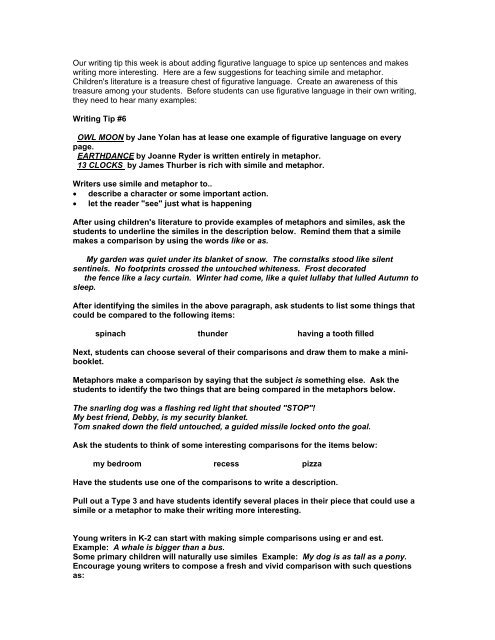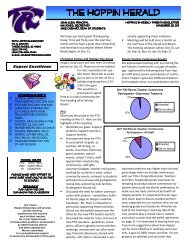Our writing tip this week is about adding figurative language to spice ...
Our writing tip this week is about adding figurative language to spice ...
Our writing tip this week is about adding figurative language to spice ...
Create successful ePaper yourself
Turn your PDF publications into a flip-book with our unique Google optimized e-Paper software.
<strong>Our</strong> <strong>writing</strong> <strong>tip</strong> <strong>th<strong>is</strong></strong> <strong>week</strong> <strong>is</strong> <strong>about</strong> <strong>adding</strong> <strong>figurative</strong> <strong>language</strong> <strong>to</strong> <strong>spice</strong> up sentences and makes<br />
<strong>writing</strong> more interesting. Here are a few suggestions for teaching simile and metaphor.<br />
Children's literature <strong>is</strong> a treasure chest of <strong>figurative</strong> <strong>language</strong>. Create an awareness of <strong>th<strong>is</strong></strong><br />
treasure among your students. Before students can use <strong>figurative</strong> <strong>language</strong> in their own <strong>writing</strong>,<br />
they need <strong>to</strong> hear many examples:<br />
Writing Tip #6<br />
OWL MOON by Jane Yolan has at lease one example of <strong>figurative</strong> <strong>language</strong> on every<br />
page.<br />
EARTHDANCE by Joanne Ryder <strong>is</strong> written entirely in metaphor.<br />
13 CLOCKS by James Thurber <strong>is</strong> rich with simile and metaphor.<br />
Writers use simile and metaphor <strong>to</strong>..<br />
describe a character or some important action.<br />
let the reader "see" just what <strong>is</strong> happening<br />
After using children's literature <strong>to</strong> provide examples of metaphors and similes, ask the<br />
students <strong>to</strong> underline the similes in the description below. Remind them that a simile<br />
makes a compar<strong>is</strong>on by using the words like or as.<br />
My garden was quiet under its blanket of snow. The cornstalks s<strong>to</strong>od like silent<br />
sentinels. No footprints crossed the un<strong>to</strong>uched whiteness. Frost decorated<br />
the fence like a lacy curtain. Winter had come, like a quiet lullaby that lulled Autumn <strong>to</strong><br />
sleep.<br />
After identifying the similes in the above paragraph, ask students <strong>to</strong> l<strong>is</strong>t some things that<br />
could be compared <strong>to</strong> the following items:<br />
spinach thunder having a <strong>to</strong>oth filled<br />
Next, students can choose several of their compar<strong>is</strong>ons and draw them <strong>to</strong> make a minibooklet.<br />
Metaphors make a compar<strong>is</strong>on by saying that the subject <strong>is</strong> something else. Ask the<br />
students <strong>to</strong> identify the two things that are being compared in the metaphors below.<br />
The snarling dog was a flashing red light that shouted "STOP"!<br />
My best friend, Debby, <strong>is</strong> my security blanket.<br />
Tom snaked down the field un<strong>to</strong>uched, a guided m<strong>is</strong>sile locked on<strong>to</strong> the goal.<br />
Ask the students <strong>to</strong> think of some interesting compar<strong>is</strong>ons for the items below:<br />
my bedroom recess pizza<br />
Have the students use one of the compar<strong>is</strong>ons <strong>to</strong> write a description.<br />
Pull out a Type 3 and have students identify several places in their piece that could use a<br />
simile or a metaphor <strong>to</strong> make their <strong>writing</strong> more interesting.<br />
Young writers in K-2 can start with making simple compar<strong>is</strong>ons using er and est.<br />
Example: A whale <strong>is</strong> bigger than a bus.<br />
Some primary children will naturally use similes Example: My dog <strong>is</strong> as tall as a pony.<br />
Encourage young writers <strong>to</strong> compose a fresh and vivid compar<strong>is</strong>on with such questions<br />
as:
What did it look like <strong>to</strong> you?<br />
What did it seem like <strong>to</strong> you? Emphasizing the word, like.<br />
Examples: The cars were crawling like ants.<br />
It's sticky like pancake syrup.<br />
Den<strong>is</strong>e Cole has suggest that you might want <strong>to</strong> look at the following two websites that<br />
have hilarious s<strong>to</strong>ry starters and plans that include rubrics.<br />
http:www.brucevanpatter.com/yours<strong>to</strong>ries/<br />
www.readwritethink.org<br />
Thank you Den<strong>is</strong>e!<br />
Next <strong>week</strong> we will include lessons for "specificity"!<br />
Your <strong>writing</strong> committee!




